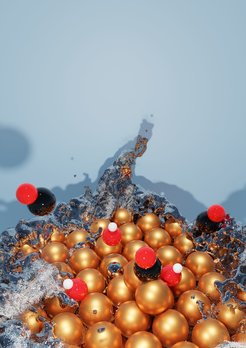Dynamics as a new grip on the Sabatier Principle

Catalysts accelerate chemical reactions and thus make them useable for large-scale technological applications. They are therefore needed more than ever. Not least for a sustainable supply of energy, for they are at the core of fuel cells that convert chemical into electrical energy. Efficient catalysts are also important for splitting water into hydrogen or producing synthetic fuels. Unfortunately, presently these catalysts often consist of rare elements such as platinum or iridium, which are either very expensive to obtain or not available in the quantities needed for a global energy supply. Therefore, catalysis research is looking for more abundant alternatives.
The search is aided by the century-old Sabatier Principle. It states that a good catalyst material should bind the molecules that participate in the chemical reaction neither too strongly nor too weakly to its surface. The bonds should be strong enough to activate the molecules for the reaction, but still weak enough to not hold on to them forever. Unfortunately, many materials follow so-called scaling relations. They tend to bind different molecules either all stronger or all weaker, while for many reactions catalysts are needed that selectively bind certain molecules stronger and others weaker.
In their work published in Nature Catalysis, the team around Prof. Julia Kunze-Liebhäuser from the University of Innsbruck and Prof. Karsten Reuter, Director of the Theory Department at the Fritz-Haber-Institute, show that during the electrooxidation reaction of carbon monoxide (CO) copper (Cu) catalysts have their own solution to this problem. Carbon monoxide is an intermediate product that is produced during the conversion of fuels in fuel cells. To prevent the fuel cell from being poisoned, it must be disposed of through the electrooxidation reaction.
During the reaction, the scientists observed that the copper surface is continuously converted and that small islands consisting of a few copper atoms are continuously formed. The charge of adsorbing ions gets stored in these protruding, nanometer-sized clusters. In the studied electrooxidation reaction in the used alkaline electrolyte this is especially the charge of the involved hydroxide (OH-) ions. This leads to fundamentally different binding properties to the catalyst than for the neutral reaction partner CO. The hydroxide ions are bound weaker, the CO stronger - exactly the mixture required for the observed high catalytic activity.
The possibility of changing the binding strength separately and individually for neutral and charged molecules through cluster-like protrusions on the catalyst’s surface could represent a completely new approach to fulfilling the Sabatier Principle. On Cu these clusters form spontaneously during the dynamic restructuring of the surface under reaction conditions. In the future, one might want to create them deliberately via rational catalyst design.












